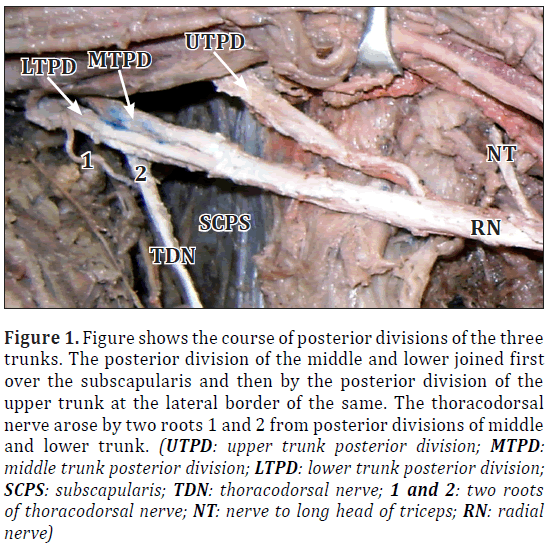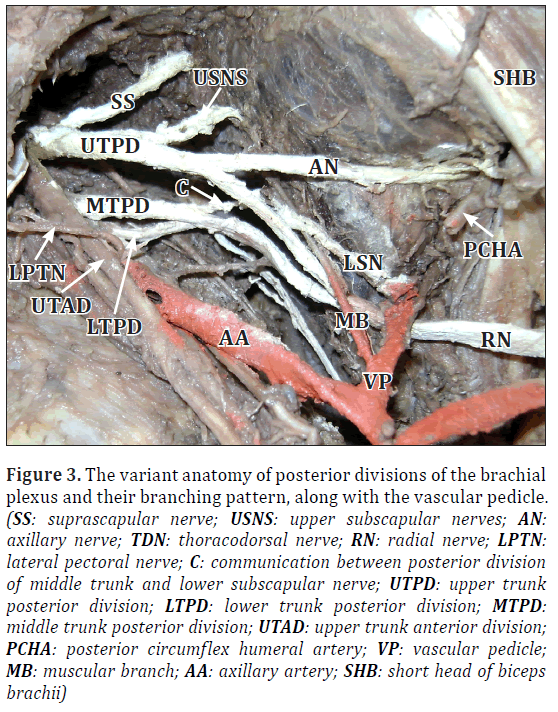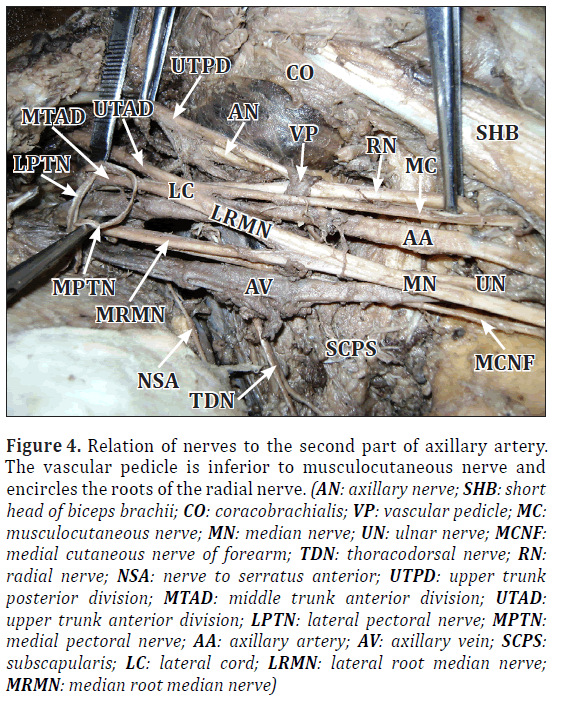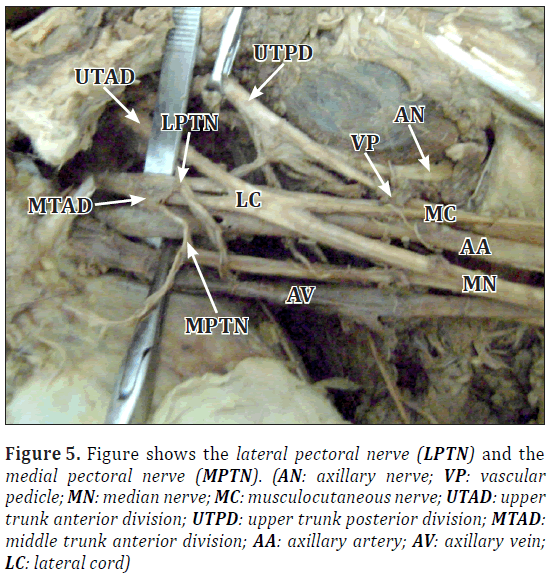Concomitant variations of the brachial plexus and third part of axillary artery in a middle aged female cadaver: an original case report
Jaba Rajguru*, Antima Gupta and Shilpi Jain
Department of Anatomy, Subharti Medical College, Meerut, India.
- *Corresponding Author:
- Jaba Rajguru
Assistant Professor, Department of Anatomy Subharti Medical College, Subhartipuram Meerut, INDIA.
Tel: +91 844 9733713
E-mail: hibiscusemily@yahoo.com
Date of Received: February 9th, 2013
Date of Accepted: October 9th, 2013
Published Online: May 16th, 2014
© Int J Anat Var (IJAV). 2014; 7: 10–13.
[ft_below_content] =>Keywords
posterior cord,common vascular pedicle,axillary artery,axillary artery
Introduction
The brachial plexus is a complex network of nerves extending from the neck to axilla supplying motor sensory and sympathetic fibers to the upper extremity and superficial muscles of the back. It is formed by the fusion of the anterior primary rami of the C5, C6, C7, C8, and T1 spinal nerves, with occasional communications from C4 and T2 making it either pre-fixed or post-fixed, respectively.
The C5 and C6 form the upper trunk, the C7 continues as the middle trunk and the C8 and T1 join to form the lower trunk. The anterior divisions of the upper and middle trunks form the lateral cord, the lower trunk continues as the medial cord, and the posterior divisions of all three trunks form the posterior cord, which gives terminal branches at the lower border of pectoralis minor, the various branches that form the peripheral nerves of the upper limb [1]. The brachial plexus is divided into supraclavicular and infraclavicular parts. The roots and the trunk lie in the neck, the divisions behind the clavicle, cords and branches in the axilla [1]. The various branches of the plexus are derived from the roots, trunks and cords but none from the divisions [2]. The cords of the brachial plexus, i.e. the lateral, medial and posterior cords lie lateral, medial and posterior respectively, to the second part axillary artery. The axillary artery gives three separate branches in its third part which are the subscapular artery, anterior and posterior humeral circumflex arteries.
Case Report
During undergraduate dissection at Jawaharlal Nehru Medical College, Sawangi, (Meghe), Wardha, variations of the brachial plexus and axillary artery were found in the left upper limb of a middle aged female cadaver. The clavicle was cut and the brachial plexus were exposed till the roots. The C5 and C6 root ran individually till above the upper border of clavicle and joined to form the upper trunk, which bifurcated into anterior and posterior divisions. The posterior divisions of the middle and lower trunks united first over the substance of the subscapularis muscle and then joined with the posterior division of the upper trunk at the lateral border of subscapularis muscle, and continued as the radial nerve as seen in Figure 1. The upper and the lower subscapular nerves, and the axillary nerve were branches of posterior division of upper trunk (Figure 2). There were three upper subscapular nerves, named as USN1, USN2 and USN3, respectively. USN1 formed a loop with USN2. The lower subscapular nerve originated distal to the axillary nerve, in between the axillary nerve and the root to the radial nerve (Figure 2). Communication was seen between the posterior division of the middle trunk and the lower subscapular nerve (Figure 3). The thoracodorsal nerve arose from the posterior divisions of the middle and lower trunk by two roots before their fusion (Figures 1–4). The lateral pectoral nerve and the medial pectoral nerve were branches of anterior divisions of the upper trunk and middle trunk, respectively (Figures 4, 5).
Figure 1: Figure shows the course of posterior divisions of the three trunks. The posterior division of the middle and lower joined first over the subscapularis and then by the posterior division of the upper trunk at the lateral border of the same. The thoracodorsal nerve arose by two roots 1 and 2 from posterior divisions of middle and lower trunk. (UTPD: upper trunk posterior division; MTPD: middle trunk posterior division; LTPD: lower trunk posterior division; SCPS: subscapularis; TDN: thoracodorsal nerve; 1 and 2: two roots of thoracodorsal nerve; NT: nerve to long head of triceps; RN: radial nerve)
Figure 2: Figure shows branches from the posterior division of the upper trunk and the common vascular pedicle encircling the roots of the radial nerve (SS: suprascapular nerve; 1, 2 and 3: upper subscapular nerves; AN: axillary nerve; LSN: lower subscapular nerve; TDN1 and TDN2: two roots of thoracodorsal nerve; RN: radial nerve; UTPD: upper trunk posterior division; AA: axillary artery; VP: vascular pedicle; ACHA: anterior circumflex humeral artery; PCHA: posterior circumflex humeral artery; MB: muscular branch; CL: clavicle)
Figure 3: The variant anatomy of posterior divisions of the brachial plexus and their branching pattern, along with the vascular pedicle. (SS: suprascapular nerve; USNS: upper subscapular nerves; AN: axillary nerve; TDN: thoracodorsal nerve; RN: radial nerve; LPTN: lateral pectoral nerve; C: communication between posterior division of middle trunk and lower subscapular nerve; UTPD: upper trunk posterior division; LTPD: lower trunk posterior division; MTPD: middle trunk posterior division; UTAD: upper trunk anterior division; PCHA: posterior circumflex humeral artery; VP: vascular pedicle; MB: muscular branch; AA: axillary artery; SHB: short head of biceps brachii)
Figure 4: Relation of nerves to the second part of axillary artery. The vascular pedicle is inferior to musculocutaneous nerve and encircles the roots of the radial nerve. (AN: axillary nerve; SHB: short head of biceps brachii; CO: coracobrachialis; VP: vascular pedicle; MC: musculocutaneous nerve; MN: median nerve; UN: ulnar nerve; MCNF: medial cutaneous nerve of forearm; TDN: thoracodorsal nerve; RN: radial nerve; NSA: nerve to serratus anterior; UTPD: upper trunk posterior division; MTAD: middle trunk anterior division; UTAD: upper trunk anterior division; LPTN: lateral pectoral nerve; MPTN: medial pectoral nerve; AA: axillary artery; AV: axillary vein; SCPS: subscapularis; LC: lateral cord; LRMN: lateral root median nerve; MRMN: median root median nerve)
Figure 5: Figure shows the lateral pectoral nerve (LPTN) and the medial pectoral nerve (MPTN). (AN: axillary nerve; VP: vascular pedicle; MN: median nerve; MC: musculocutaneous nerve; UTAD: upper trunk anterior division; UTPD: upper trunk posterior division; MTAD: middle trunk anterior division; AA: axillary artery; AV: axillary vein; LC: lateral cord)
Variations were observed in relations of the nerves to axillary artery (Figures 4, 5). The terminal portion of the anterior divisions of the upper and middle trunk and the lateral cord, were anterior to the axillary artery in its second part. The posterior division of the upper trunk was posterolateral, while the middle and lower divisions of the same were posterior to the axillary artery.
The axillary artery gave only a single branch in its third part in form of a common vascular pedicle which coursed upwards inferior to the musculocutaneous nerve (Figures 4, 5), encircled the roots of the radial nerve and continued downwards to inferior angle of scapula as the thoracodorsal artery. The anterior circumflex humeral artery, the posterior circumflex humeral artery, the circumflex scapular artery and unnamed muscular branches were given from this pedicle (Figures 1, 2). The brachial plexus and the axillary artery of right side had usual anatomy.
Discussion
The limbs are formed by the somites which bring their own nerve supply as they migrate during the embryonic life. The brachial plexus appears as a single radical cone in the upper limb which divides longitudinally into dorsal (radial and axillary nerves) and ventral (median and ulnar nerves) divisions [3]. The guidance of the developing axons is regulated by chemo-attractants and chemo-repulsants in a highly coordinated and a specific fashion [4]. Any alterations in signaling manner between mesenchymal cells and neuronal growth lead to significant variations which once formed persists postnatally [3]. Also in embryos, the seventh cervical intersegmental artery enlarges and becomes the dominant vessel of axilla. The other segmental arteries and most of the longitudinal anastomoses degenerate. The numerous alternatives that exist during the formation of upper limb vessels seem to be responsible for unusual arterial branching patterns [4,5]. Variations of posterior cord [3,6], the upper subscapular nerve arising as a direct branch from the posterior division of the upper trunk [7,8], the lateral and the medial pectoral nerves arising from anterior divisions of the upper and middle trunks, respectively [8,9] and a common vascular pedicle from the third part of axillary artery [10,11] has been found in recent literature. However, encircling of the radial nerve by the common vascular pedicle has not been described as yet, to the best of our knowledge.
References
- Decker G, Du Plessis D. Lee McGregor’s Synopsis of Surgical Anatomy. 12th Ed., Bombay, Varghese Publishing House.1986; 375–395.
- Sinnatamby CS. Last’s Anatomy. Regional and Applied. 11th Ed., Edinburgh, Churchill Livingstone, Elsevier. 2006; 39–113 .
- Pandey SK, Shukla VK. Anatomical variations of the cords of brachial plexus and the median nerve. Clin Anat. 2007; 20: 150–156.
- Sannes HD, Reh TA, Harris WA. Development of the nervous system: Axon growth and guidance. New York, Academic Press. 2000; 189–197.
- Iwata H. Studies on the development of the brachial plexus in Japanese embryo. Rep Dept Anat Mie Prefect Univ Sch Med. 1960;13: 129–144.
- Gupta M, Goyal N, Harjeet. Bilaterally anomalous formation and distribution of posterior cord of brachial plexus. Nepal Med Coll J. 2004; 6: 133–135.
- Kerr AT. The brachial plexus of nerves in man, the variations in its formation and branches. Am J Anat. 1918; 23: 285–395.
- Fazan VPS, Amadeu AS, Calaffi AL, Rodrigues Filho OA. Brachial Plexus variations in its formation and main branches. Acta Cir Bras. 2001; 18: 14–18.
- Loukas M, Louis RG Jr, Fitzsimmons J, Colborn G. The surgical anatomy of the ansa pectoralis. Clin Anat. 2006; 19: 685–693.
- Saralaya V, Joy T, Madhyastha S, Vadgaonkar R, Saralaya S. Abnormal branching of the axillary artery: subscapular common trunk. A case report. Int J Morphol. 2008; 26: 963–966.
- Venieratos D, Lolis ED. Abnormal ramification of the axillary artery: sub scapular common trunk. Morphologie. 2001; 85: 23–24. (French)
Jaba Rajguru*, Antima Gupta and Shilpi Jain
Department of Anatomy, Subharti Medical College, Meerut, India.
- *Corresponding Author:
- Jaba Rajguru
Assistant Professor, Department of Anatomy Subharti Medical College, Subhartipuram Meerut, INDIA.
Tel: +91 844 9733713
E-mail: hibiscusemily@yahoo.com
Date of Received: February 9th, 2013
Date of Accepted: October 9th, 2013
Published Online: May 16th, 2014
© Int J Anat Var (IJAV). 2014; 7: 10–13.
Abstract
Variations of the brachial plexus and axillary artery were found in the left side of a female cadaver during undergraduate dissection in Jawaharlal Nehru Institute of Medical Sciences, Sawangi (Meghe) Wardha. The C5 and C6 root ran individually till above the upper border of clavicle and joined to form the upper trunk, which, bifurcated into anterior and posterior divisions. The posterior divisions of the middle and lower trunks united first and then with that of the upper at the lateral border of the subscapularis and continued as the radial nerve. The upper subscapular, lower subscapular and the axillary nerves were branches of the posterior divisions of the upper trunk. This was associated with variation in the third part of axillary artery, which was in form of a common vascular pedicle which encircled the roots of radial nerve. The variations as found, assume importance during therapeutic and invasive procedures undertaken in this region.
-Keywords
posterior cord,common vascular pedicle,axillary artery,axillary artery
Introduction
The brachial plexus is a complex network of nerves extending from the neck to axilla supplying motor sensory and sympathetic fibers to the upper extremity and superficial muscles of the back. It is formed by the fusion of the anterior primary rami of the C5, C6, C7, C8, and T1 spinal nerves, with occasional communications from C4 and T2 making it either pre-fixed or post-fixed, respectively.
The C5 and C6 form the upper trunk, the C7 continues as the middle trunk and the C8 and T1 join to form the lower trunk. The anterior divisions of the upper and middle trunks form the lateral cord, the lower trunk continues as the medial cord, and the posterior divisions of all three trunks form the posterior cord, which gives terminal branches at the lower border of pectoralis minor, the various branches that form the peripheral nerves of the upper limb [1]. The brachial plexus is divided into supraclavicular and infraclavicular parts. The roots and the trunk lie in the neck, the divisions behind the clavicle, cords and branches in the axilla [1]. The various branches of the plexus are derived from the roots, trunks and cords but none from the divisions [2]. The cords of the brachial plexus, i.e. the lateral, medial and posterior cords lie lateral, medial and posterior respectively, to the second part axillary artery. The axillary artery gives three separate branches in its third part which are the subscapular artery, anterior and posterior humeral circumflex arteries.
Case Report
During undergraduate dissection at Jawaharlal Nehru Medical College, Sawangi, (Meghe), Wardha, variations of the brachial plexus and axillary artery were found in the left upper limb of a middle aged female cadaver. The clavicle was cut and the brachial plexus were exposed till the roots. The C5 and C6 root ran individually till above the upper border of clavicle and joined to form the upper trunk, which bifurcated into anterior and posterior divisions. The posterior divisions of the middle and lower trunks united first over the substance of the subscapularis muscle and then joined with the posterior division of the upper trunk at the lateral border of subscapularis muscle, and continued as the radial nerve as seen in Figure 1. The upper and the lower subscapular nerves, and the axillary nerve were branches of posterior division of upper trunk (Figure 2). There were three upper subscapular nerves, named as USN1, USN2 and USN3, respectively. USN1 formed a loop with USN2. The lower subscapular nerve originated distal to the axillary nerve, in between the axillary nerve and the root to the radial nerve (Figure 2). Communication was seen between the posterior division of the middle trunk and the lower subscapular nerve (Figure 3). The thoracodorsal nerve arose from the posterior divisions of the middle and lower trunk by two roots before their fusion (Figures 1–4). The lateral pectoral nerve and the medial pectoral nerve were branches of anterior divisions of the upper trunk and middle trunk, respectively (Figures 4, 5).
Figure 1: Figure shows the course of posterior divisions of the three trunks. The posterior division of the middle and lower joined first over the subscapularis and then by the posterior division of the upper trunk at the lateral border of the same. The thoracodorsal nerve arose by two roots 1 and 2 from posterior divisions of middle and lower trunk. (UTPD: upper trunk posterior division; MTPD: middle trunk posterior division; LTPD: lower trunk posterior division; SCPS: subscapularis; TDN: thoracodorsal nerve; 1 and 2: two roots of thoracodorsal nerve; NT: nerve to long head of triceps; RN: radial nerve)
Figure 2: Figure shows branches from the posterior division of the upper trunk and the common vascular pedicle encircling the roots of the radial nerve (SS: suprascapular nerve; 1, 2 and 3: upper subscapular nerves; AN: axillary nerve; LSN: lower subscapular nerve; TDN1 and TDN2: two roots of thoracodorsal nerve; RN: radial nerve; UTPD: upper trunk posterior division; AA: axillary artery; VP: vascular pedicle; ACHA: anterior circumflex humeral artery; PCHA: posterior circumflex humeral artery; MB: muscular branch; CL: clavicle)
Figure 3: The variant anatomy of posterior divisions of the brachial plexus and their branching pattern, along with the vascular pedicle. (SS: suprascapular nerve; USNS: upper subscapular nerves; AN: axillary nerve; TDN: thoracodorsal nerve; RN: radial nerve; LPTN: lateral pectoral nerve; C: communication between posterior division of middle trunk and lower subscapular nerve; UTPD: upper trunk posterior division; LTPD: lower trunk posterior division; MTPD: middle trunk posterior division; UTAD: upper trunk anterior division; PCHA: posterior circumflex humeral artery; VP: vascular pedicle; MB: muscular branch; AA: axillary artery; SHB: short head of biceps brachii)
Figure 4: Relation of nerves to the second part of axillary artery. The vascular pedicle is inferior to musculocutaneous nerve and encircles the roots of the radial nerve. (AN: axillary nerve; SHB: short head of biceps brachii; CO: coracobrachialis; VP: vascular pedicle; MC: musculocutaneous nerve; MN: median nerve; UN: ulnar nerve; MCNF: medial cutaneous nerve of forearm; TDN: thoracodorsal nerve; RN: radial nerve; NSA: nerve to serratus anterior; UTPD: upper trunk posterior division; MTAD: middle trunk anterior division; UTAD: upper trunk anterior division; LPTN: lateral pectoral nerve; MPTN: medial pectoral nerve; AA: axillary artery; AV: axillary vein; SCPS: subscapularis; LC: lateral cord; LRMN: lateral root median nerve; MRMN: median root median nerve)
Figure 5: Figure shows the lateral pectoral nerve (LPTN) and the medial pectoral nerve (MPTN). (AN: axillary nerve; VP: vascular pedicle; MN: median nerve; MC: musculocutaneous nerve; UTAD: upper trunk anterior division; UTPD: upper trunk posterior division; MTAD: middle trunk anterior division; AA: axillary artery; AV: axillary vein; LC: lateral cord)
Variations were observed in relations of the nerves to axillary artery (Figures 4, 5). The terminal portion of the anterior divisions of the upper and middle trunk and the lateral cord, were anterior to the axillary artery in its second part. The posterior division of the upper trunk was posterolateral, while the middle and lower divisions of the same were posterior to the axillary artery.
The axillary artery gave only a single branch in its third part in form of a common vascular pedicle which coursed upwards inferior to the musculocutaneous nerve (Figures 4, 5), encircled the roots of the radial nerve and continued downwards to inferior angle of scapula as the thoracodorsal artery. The anterior circumflex humeral artery, the posterior circumflex humeral artery, the circumflex scapular artery and unnamed muscular branches were given from this pedicle (Figures 1, 2). The brachial plexus and the axillary artery of right side had usual anatomy.
Discussion
The limbs are formed by the somites which bring their own nerve supply as they migrate during the embryonic life. The brachial plexus appears as a single radical cone in the upper limb which divides longitudinally into dorsal (radial and axillary nerves) and ventral (median and ulnar nerves) divisions [3]. The guidance of the developing axons is regulated by chemo-attractants and chemo-repulsants in a highly coordinated and a specific fashion [4]. Any alterations in signaling manner between mesenchymal cells and neuronal growth lead to significant variations which once formed persists postnatally [3]. Also in embryos, the seventh cervical intersegmental artery enlarges and becomes the dominant vessel of axilla. The other segmental arteries and most of the longitudinal anastomoses degenerate. The numerous alternatives that exist during the formation of upper limb vessels seem to be responsible for unusual arterial branching patterns [4,5]. Variations of posterior cord [3,6], the upper subscapular nerve arising as a direct branch from the posterior division of the upper trunk [7,8], the lateral and the medial pectoral nerves arising from anterior divisions of the upper and middle trunks, respectively [8,9] and a common vascular pedicle from the third part of axillary artery [10,11] has been found in recent literature. However, encircling of the radial nerve by the common vascular pedicle has not been described as yet, to the best of our knowledge.
References
- Decker G, Du Plessis D. Lee McGregor’s Synopsis of Surgical Anatomy. 12th Ed., Bombay, Varghese Publishing House.1986; 375–395.
- Sinnatamby CS. Last’s Anatomy. Regional and Applied. 11th Ed., Edinburgh, Churchill Livingstone, Elsevier. 2006; 39–113 .
- Pandey SK, Shukla VK. Anatomical variations of the cords of brachial plexus and the median nerve. Clin Anat. 2007; 20: 150–156.
- Sannes HD, Reh TA, Harris WA. Development of the nervous system: Axon growth and guidance. New York, Academic Press. 2000; 189–197.
- Iwata H. Studies on the development of the brachial plexus in Japanese embryo. Rep Dept Anat Mie Prefect Univ Sch Med. 1960;13: 129–144.
- Gupta M, Goyal N, Harjeet. Bilaterally anomalous formation and distribution of posterior cord of brachial plexus. Nepal Med Coll J. 2004; 6: 133–135.
- Kerr AT. The brachial plexus of nerves in man, the variations in its formation and branches. Am J Anat. 1918; 23: 285–395.
- Fazan VPS, Amadeu AS, Calaffi AL, Rodrigues Filho OA. Brachial Plexus variations in its formation and main branches. Acta Cir Bras. 2001; 18: 14–18.
- Loukas M, Louis RG Jr, Fitzsimmons J, Colborn G. The surgical anatomy of the ansa pectoralis. Clin Anat. 2006; 19: 685–693.
- Saralaya V, Joy T, Madhyastha S, Vadgaonkar R, Saralaya S. Abnormal branching of the axillary artery: subscapular common trunk. A case report. Int J Morphol. 2008; 26: 963–966.
- Venieratos D, Lolis ED. Abnormal ramification of the axillary artery: sub scapular common trunk. Morphologie. 2001; 85: 23–24. (French)











